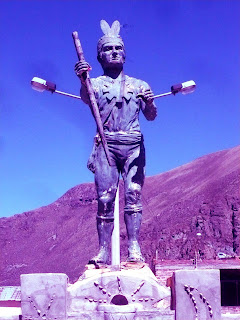 |
| Jim and his "Facebook" disguise from The Office. |
 |
| We're not building a haunted house. These are mannequins for the Tuti museum. |
After much searching, we also found a runner that I can nail to the museum celing and from which I can hang exhibition panels and photos. When I return to Tuti this coming week, I will be painting the wall yellow and trying to cover up any stains I see. I would hate to starts hammering nails into the fresh paint, only to have to take them out and move them later on. I've also seen how some nails, once stuck into the cement, are stuck forever. I definitely don't want to leave behind a wall full of nails or holes!
I saw a similar type of runner used at the Contemporary Art Gallery here in Arequipa, so I knew it could work. What we bought actually was a runner for a curtain, but it works just the same. To cover the whole length of the wall, I bought two runners 3 meters long. It was fun trying to bring it back to our apartment. You can see below how the runners almost reach the ceiling in our apartment!
 |
| Giant curtain runner!!! |
I made up for that this week.
It was actually a great week of art and crafts. Saturday I went to the studio and took advantage of the great view of the cathedral and the mountain range behind it. I worked small, but it was nice to get the paint moving again. When I got home, I started working on a painting I had previously started, of the mountain just behind the municipality in Tuti. Both are unfinished, I'll have to upload photos later. In the past I concentrated on the figure, but since coming to Peru I've been working principally on landscapes, and with a more muted color palette.
Monday, a friend of ours invited us to go to a Chirstmas arts and crafts fair held in the gym of a local high school. It was great. There were two techniques that really caught my eye. One is called ceramica fria. You buy a mass of white play-doh which sticks to a hard surface (wood) with water and pressure. Then you can paint over the sculpture/painting with acrylic paint. Its a great way to give three-dimensionality to a painting. We started on our first paintings, below is an image of mine with only the drawing and the white mass. I'm still working on the color; the acrylic painting isn't working out like I thought and I might have to switch to oil.
 |
| Drawing supplemented with ceramica fria to make it more 3-D. |
 |
| First attempt working in ceramica fria. |
Currently, I am waiting to here from the mayor to see if there is a private car going to Tuti that will help me carry all the supplies I bought for the museum. I cringe thinking of trying to take everything up to the valley by bus! A few more clothes to wash on the roof, and then I'll be ready to enjoy Halloween night. Here's hoping everyone has a great holiday!
Ciao!
p.s. We're going into summer down here, so I thought a summer haircut might be in order:
 |
| I'm back to brunette! |














